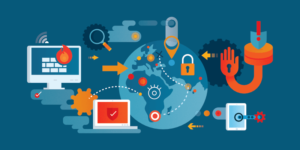Online Security threats have expanded dramatically, and hackers have become even more sophisticated. Organizations are under attack from all directions as cybercrime has become big business. In this article, you will get to know user awareness and online security.

What does User Awareness mean?
A component of a company’s security policy, including education and testing individuals, to help protect and secure your organization against cybercriminals and other social-engineering attacks. The security of your organization relies on a sound digital infrastructure and an analyst team that can support it. 95% of online cybersecurity breaches are due to human error, and 38% of global organizations state that they’re prepared to handle a sophisticated cyber-attack.
Social engineering is a favorite tactic among cybercriminals from psychological manipulation of victims to convince them to willingly or unwillingly surrender private data. Ransomware and malware are also a constant threat with people downloading apps or softwares that are designed for compromising their devices or providing network access to hackers.
Who are the End users?
End users here are those types of employees whom hackers may target depending on the area of work, organizations, or at the individual level — basically anyone with an internet connection providing access to your company’s sensitive information.
Human error has become a major weak point today; cybercriminals exploit the easy one. Not educating your end-users in cybersecurity initiatives like trying to keep an attack away. End-users are the first line of defense against online cybersecurity attacks. Here are three steps that can be at your top of mind for your organization.
1. Implementing a cybersecurity policy and procedure document:
First, you need a cybersecurity policy and procedure document in place. This document shall contain a section that has details of action items, in case if your end-users encounter compromises. It doesn’t matter if you’re a one-person organization or a 10,000 person organization-you need to detail your action items long before a threat is identified.
2. Build your cybersecurity strategy around educating your employees:
Education and knowledge is the very first parameter when it comes to online security awareness. Almost every employee or person in this world has an email address and access to the internet. From a hacker’s perspective, it’s far easier to send a phishing email or link to you and let you do all the hard work for them by clicking on that link.
3. Having cybersecurity tools in place to help prevent the compromise:
Cybersecurity protection doesn’t come from telling your end-users not to visit a site they shouldn’t. We are humans, and we make mistakes. All you have to do is keep your tools in place like firewall, threat protection, anti-spyware when you end-users by mistakenly slip up.

Phishing and Social Engineering:
Social engineering is defined as an online attack that’s based on compromised users or administrators into divulging information. Phishing is an attempt to acquire sensitive information like passwords, usernames, payment details from an individual or from an organization through email, chat, or other means is a common type of social engineering attack.
The reason because this phishing and other social engineering attacks are so successful is that they’re disguised to look like they come from legitimate and trustworthy sources – forcing a sense of trust. One can easily spot a difference between legal and illegitimate online links or attachments, such as typos and misspellings, links having random numbers and letters, email relying on a sense of urgency.
Remember and keep in mind that every company or organization is different. The following are some useful tactics for online security, no matter what industry you’re in.
1. Invest in Security Awareness:
It doesn’t matter if your company is taking online security awareness seriously for their end-users or not; it can be found out by just looking at their budgets. Many companies and organizations spend the bulk of their IT security budgets on security softwares. But it means nothing when a user manipulates into allowing the attacker’s access.
2. Regular Testing should be done:
Testing must be a priority at an organization level as well as an individual level. The devices which you use- computer systems, laptops, tablets, and mobile phones can be compromised. It is necessary to keep a close eye on every link you open via email or every URL you visit during browsing online.
Companies and organizations shall conduct regular drills in which someone will try to phish, and their employees will simply see if they’d fall for it. It can be termed as one of the best possible tests you could use for the sake of assessing your efforts in online security awareness.
3. Keep Everyone Updated and Protected:
As far as your end-users go, regular reminders are an excellent way to make sure they continue to keep security a priority. All should be reminded and informed about new forms of online cybersecurity attacks and acts. Don’t just simply highlight the ones you see in the headlines. You shall show them examples and conduct training lessons that will resonate with their knowledge about online security.
Online cybersecurity defense training should be an ongoing investment in your company and not just running org-wide security awareness training and then thinking that single course engagement protects them from moving forward. Each year, month, week. New threats arise. Modern malware is coded, new phishing scams are developed, and new security encryption is compromised.
Having the right security software and procedures in place is essential, but never make the same mistake of overlooking your employees’ training and fostering an environment of cybersecurity awareness in all organizational levels. When it comes to considering the cost of cybersecurity awareness and response situation training, compare the cost to prevent cyber threats from penetrating and compromising your organizations rather than the financial impact of an online cybersecurity attack.
Are you interested in knowing more about day-to-day cyber threats? Visit the Security Awareness section for more.
“Stay Updated. Stay Protected!“



